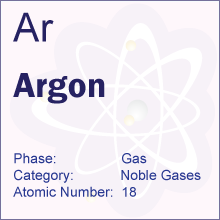 Periodic Table -> Argon
Periodic Table -> ArgonArgon
Argon DetailsArgon Symbol: Ar
Argon Atomic Number: 18
Argon Atomic Weight: 39.948
What is Argon?
Argon (Ar, atomic number 18) is the third most common gas in the world, even more so than carbon dioxide. The word "argon" means inactive, inert in Greek and refers to this gas in that it reacts with very few other elements in the periodic table. It has eight electrons in the outer shell, which make it very stable and resistant to reactions.
Argon is an odorless and colorless gas, found in the atmosphere to a small extent. It does not form chemical compounds and is heavier than air.
Argon was isolated by Sir William Ramsay and Lord Rayleigh in Scotland in 1894. They had come to the conclusion that there was another gas in the air apart from nitrogen, oxygen, and carbon dioxide because the nitrogen they got from chemical compounds was slightly lighter than nitrogen from the atmosphere. They conducted an experiment, removing all of the carbon dioxide, oxygen, water, and nitrogen from an air sample. Argon was the first noble gas that was discovered. Until 1957 its symbol was A.
Argon is produced by distilling liquid air. Liquid air is air, the temperature of which has been reduced to below freezing point, so it is condensed to a bluish moving liquid. The most common use for argon is as a shield in high-temperature industrial processes. It is very useful in this way because its inertia guarantees it will protect the welder or whatever the respective job in a high-temperature environment is. Argon keeps graphite from burning, which is why it is also used in graphite electric furnaces. It is also employed in incandescent and fluorescent lighting.

Argon is used whenever an inert gas is required, being a cheap alternative to nitrogen. When nitrogen is not inert enough, argon comes as its cheapest alternative. The element is also used when low thermal conductivity is sought as well as when electronic properties (e.g. emission spectrum or ionization) are required. While other noble gasses may serve the same purpose, this one is the cheapest to use. Argon is a byproduct from the production of both nitrogen and oxygen, whereby a cryogenic air separation device is used. Both substances have a large-scale industrial use. In addition, in its liquid form, the element has been employed in dark matter searches.
Argon is the noble gas making for a good atmosphere when air-sensitive materials are used. It is the most suitable as a shield and protection mechanism. It has a variety of other uses being the byproduct of liquid oxygen and liquid nitrogen, produced through air separation. Both liquid nitrogen and liquid oxygen are used on a large scale. Every other noble gas is produced this way too, with the exception of helium, but argon is the most viable because it is most abundant in the atmosphere. Argon is also used in the processing of reactive elements, such as titanium, and in gas metal arc welding and gas tungsten arc welding. Nitrogen and oxygen must be excluded from these processes because they tend to damage the material.
Argon is also used in the poultry industry for mass culling due to outbreaks of infections and diseases or as a more humane slaughter tool. In addition, argon is used to put out fires and avoid incurring damage to equipment.
You can
link to this page, using the code below:
Periodic Table |
Banks
© ElementsDatabase.com 2015 | Privacy | About | Contact